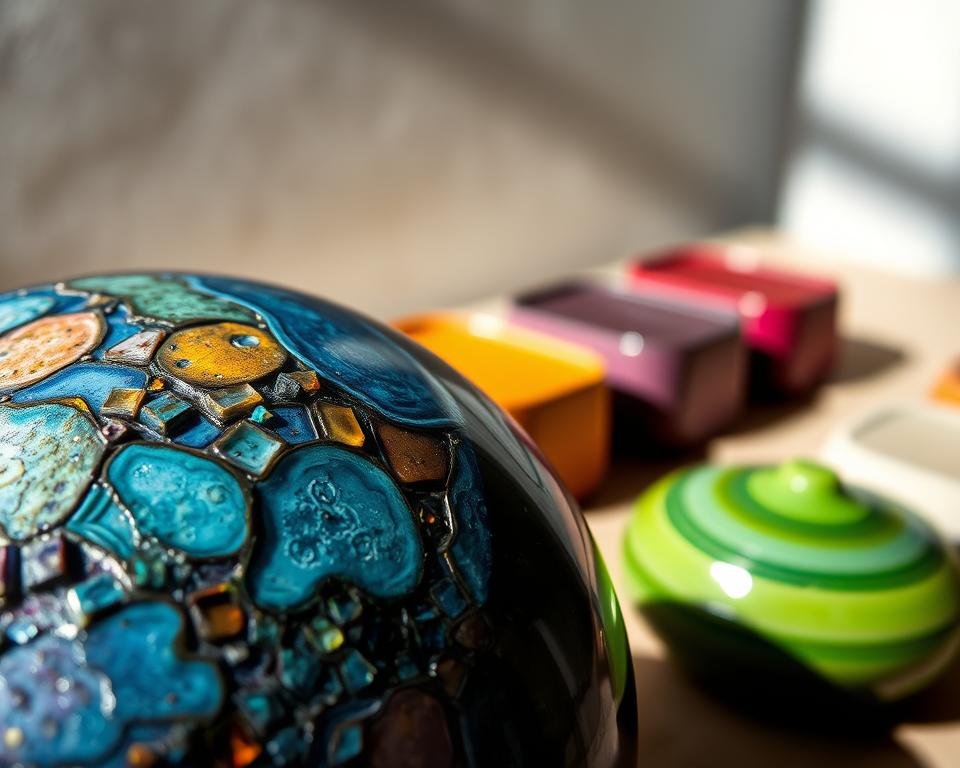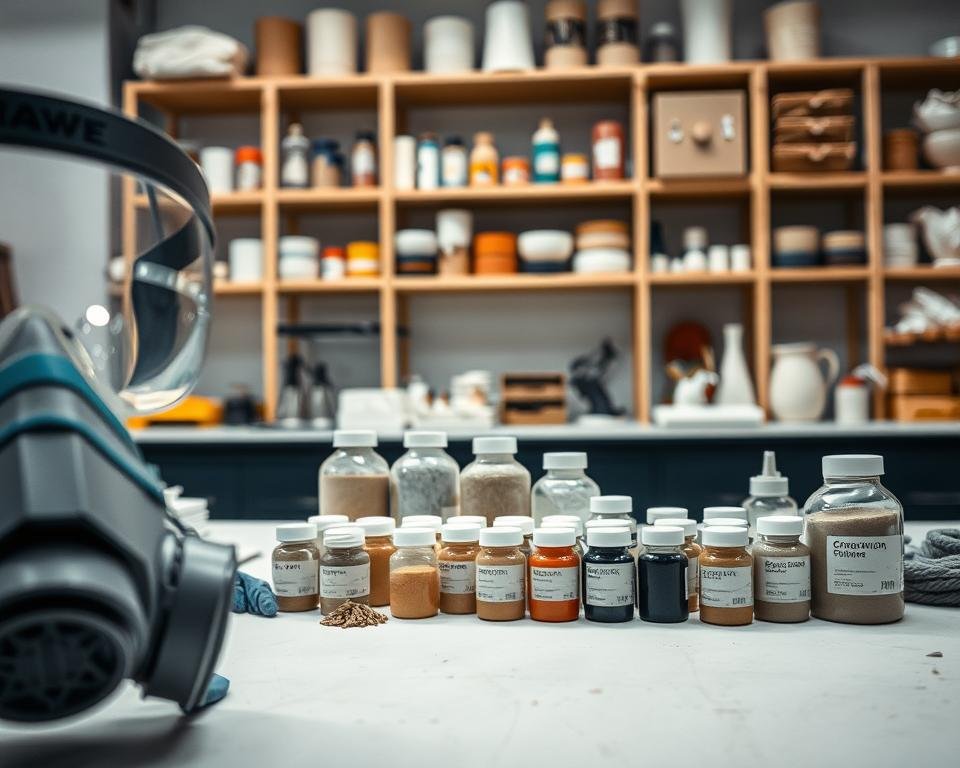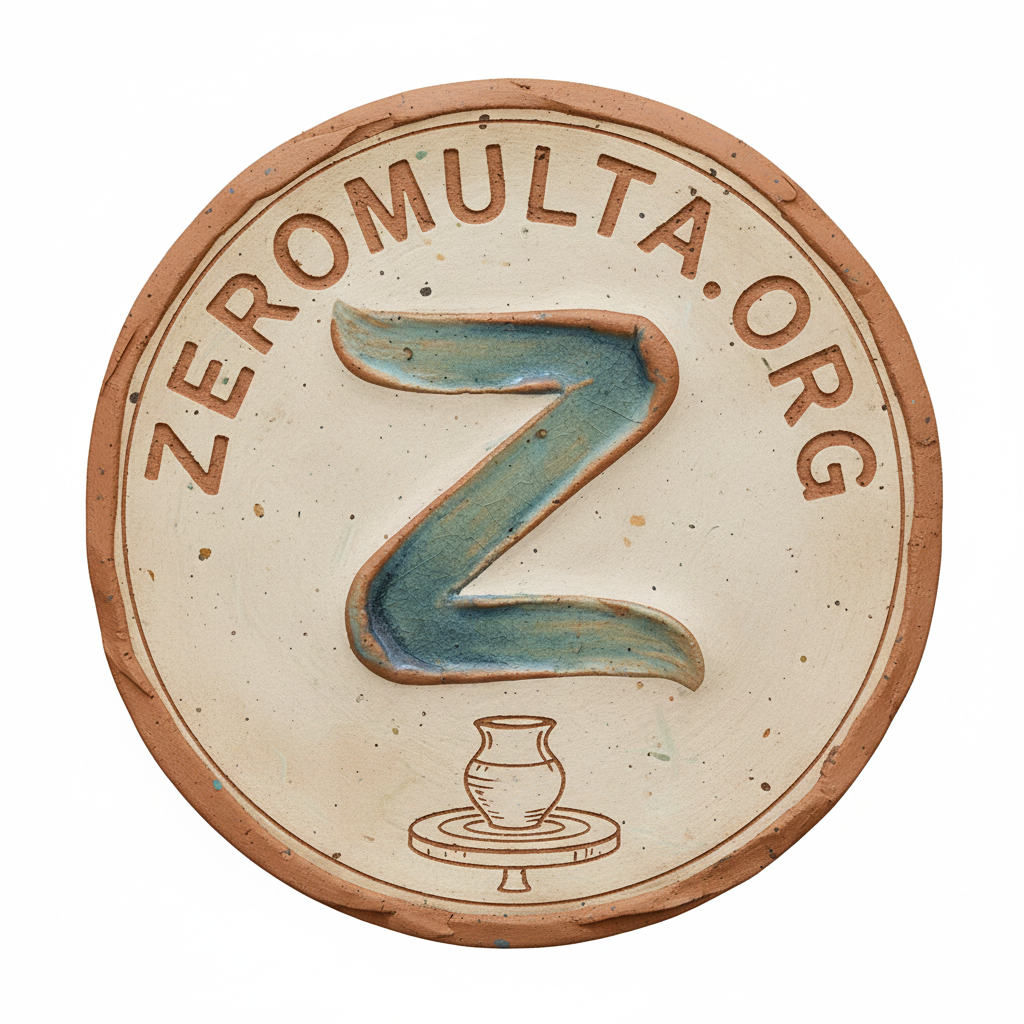Did you know that ceramic glaze additives can change how your ceramic pieces look? Using oxide coloring can bring out many vibrant colors. This turns simple glazes into amazing art.
I’ve always been amazed by oxide coloring in glaze ceramic. It can make ceramic pieces look much better. By learning how to use these additives, you can make glazes that really catch the eye.
In this article, we’ll dive into oxide coloring and its use in glaze ceramic. You’ll learn how to make stunning ceramic pieces.
Key Takeaways
- Understanding the role of oxide coloring in glaze ceramic.
- Learning how to effectively use ceramic glaze additives.
- Discovering techniques to achieve vibrant hues in your glazes.
- Exploring the creative possibilities with oxide coloring.
- Tips for applying oxide coloring to enhance your ceramic pieces.
Understanding Oxide Coloring in Ceramics
For ceramic artists, understanding oxide coloring is key to unlocking their glazes’ full beauty. This technique creates a wide range of colors, from soft pastels to bold hues. It uses metal oxides to craft rich, diverse color palettes.
What is Oxide Coloring?
Oxide coloring is the art of using metal oxides to color ceramics. Ceramic oxide pigments come from different metals, each giving a unique color when fired. Cobalt oxide, for example, produces deep blues, while copper oxide can yield greens and turquoise.
Using metal oxides in glazes helps artists achieve consistent, predictable results. By knowing how oxides interact with the glaze and firing, they can create complex, nuanced colors.
The Chemistry Behind Oxides
The chemistry of oxide coloring is based on how metal oxides change when fired. These changes result in the final color. Iron oxide, for instance, can turn yellow, red, or brown depending on the firing conditions.
The oxidation state of the metal is key to the color outcome. Some oxides, like copper, can change color significantly based on the firing atmosphere.
Historical Significance in Ceramics
Oxide coloring has been a part of ceramics for centuries. Ancient Egyptians and Chinese used metal oxides for vibrant glazes. This technique has made ceramics more durable and visually appealing.
Over time, new oxide coloring methods have emerged alongside ceramic technology advances. This has allowed artists to explore new possibilities in their craft.
Types of Oxides Used in Glazing
Oxides have been used in glazing for centuries. They help ceramic artists create a wide range of colors. These metal compounds change color when added to glazes, thanks to their chemical makeup.
Common Metallic Oxides
Metallic oxides are key in ceramic glazing. They offer a variety of colors. Here are some common ones:
- Cobalt oxide, known for its deep blue color
- Copper oxide, which can produce greens and blues depending on the glaze chemistry
- Iron oxide, used for earthy tones ranging from yellows to blacks
These oxides are essential for ceramic artists. By changing the amount and type of oxide, artists can create many different colors.
Earthy Tones and Their Sources
Natural oxides are used for earthy tones. Iron oxide, for example, creates warm, earthy colors. The exact shade depends on the iron oxide and firing conditions.
Key sources of earthy tones include:
- Iron oxide for yellows, browns, and blacks
- Manganese dioxide for browns and blacks
- Nickel oxide for greens and grays
Transition Metal Oxides for Bright Colors
Transition metal oxides are known for their bright colors. Oxides like copper and cobalt are great for colors from blues and greens to yellows and reds.
“The right combination of transition metal oxides can result in truly unique and captivating glaze colors.” – Ceramic Artist
Understanding different oxides opens up new possibilities for ceramic artists. It lets them create stunning, unique pieces.
The Glazing Process Explained
To unlock the full color of oxides, you need to understand glazing. Glazing is a process with several steps. It includes preparing the glaze, applying it, and firing it to get the right color and finish.
Steps in Preparing Glaze with Oxides
Preparing glaze with oxides needs careful ingredient selection and detail. I first pick a base glaze recipe that fits the ceramics I’m working on. Then, I add metallic oxides to get the color I want. For example, cobalt oxide gives a vibrant blue.
The right amount of oxide is key. Too little, and the color won’t show. Too much, and it might look uneven. I test small batches to find the perfect ratio.
Application Techniques for Even Coloring
Even glaze application is vital for consistent color. I use brushing, pouring, or spraying, depending on the piece’s shape and the look I want.
Controlling the ceramic firing temperature is also important. Different oxides react differently to firing temperatures. Knowing the best firing range for your oxides helps get the color right.
Copper oxide, for instance, can change from green to red with the right firing. By adjusting the firing atmosphere and temperature, I can get the color I want.
Mastering glazing and working with oxides lets ceramic artists create unique, captivating colors. Whether you’re new or experienced, trying different glazes and techniques can open up new possibilities in your work.
Color Development and Oxide Interaction
Color in oxide coloring comes from temperature and atmosphere. Knowing how these factors work together is key to getting the right colors in ceramic glazing.
How Temperature Affects Color
The firing temperature greatly affects the color of ceramics. Different oxides react in various ways to temperature, leading to many colors. For example, copper oxide can turn green at lower temperatures and bright red at higher temperatures in a reduction atmosphere.
To get consistent colors, controlling the firing temperature is vital. Even tiny changes can affect the final look. I always check my kiln’s temperature to ensure it’s right.
Reduction vs. Oxidation Atmospheres
The firing atmosphere, whether it’s reduction or oxidation, also affects color. A reduction atmosphere, with less oxygen, can change the colors of certain oxides compared to an oxidation atmosphere with plenty of oxygen.
For instance, iron oxide can create greens and blues in reduction firings but earthy tones in oxidation firings. Knowing how these atmospheres impact oxides is essential for mastering ceramic decoration.
By adjusting temperature and atmosphere, ceramic artists can create a wide range of colors and effects. This makes oxide coloring a powerful and flexible technique in ceramics.
Factors Influencing Color Results
Getting consistent colors with ceramic oxide pigments requires knowing what affects them. The color you get depends on several important things. Ceramic artists need to think about these to get the colors they want.
Base Clay Body Effects
The clay body you use is key to how colors turn out. Different clays react differently to glazes. It’s important to test glazes on the clay you’re using.
Earthenware clay makes colors warmer and more muted. Stoneware and porcelain, on the other hand, can make colors brighter and more vibrant.
| Clay Body Type | Typical Color Outcome |
|---|---|
| Earthenware | Warm, muted tones |
| Stoneware | Brighter, more saturated colors |
| Porcelain | Translucent, vibrant colors |
Glaze Composition Relationships
The glaze’s makeup is also very important. The mix of silica to alumina, the type of fluxes, and the ceramic oxide pigments used all play a part. They work together to create the final color.
“The art of glazing is not just about applying color; it’s about understanding the chemistry behind the glaze and how it interacts with the clay body.” – A renowned ceramic artist.
To get the color you want, try different glaze mixes and firing settings. Changing the glaze formula a little can make a big difference.
Knowing what affects color helps ceramic artists get the results they want. This makes the process both an art and a science.
Achieving Consistent Results
To make high-quality ceramics with bright, steady colors, artists need to get good at oxide coloring. They must understand the science behind ceramic colorants and how they mix with glazes.
Testing and Sample Firing Techniques
Testing is key to getting consistent results. Artists fire small test pieces to see the color they’ll get. This lets them tweak their glaze recipes to get the right color.
“Testing is a must in ceramics,” say experts. “It helps artists control and predict their work’s final look.”

Importance of Batch Consistency
Keeping batches the same is also vital. This means glaze ingredients, like ceramic colorants, must be measured and mixed the same way every time. If not, the final product might vary, which can upset artists aiming for uniformity.
To keep batches consistent, artists should:
- Use exact measurements for all ingredients.
- Keep a detailed log of glaze recipes and firing conditions.
- Store materials in a controlled spot to avoid contamination or damage.
By mastering testing and sample firing, and keeping batches consistent, ceramic artists can get reliable and steady results. This boosts the quality of their work.
Popular Techniques in Oxide Coloring
Potters use many techniques to color their ceramics. Oxide coloring is key in ceramics, letting artists create many colors and effects. By learning different techniques, artists can make their pottery more beautiful.
Brush vs. Spray Application
How you apply oxides changes how a piece looks. Brush application is great for detailed work and specific designs. Spray application gives a uniform look and can create soft color changes. Trying both can open up new creative paths.
Exploring different pottery glaze recipes means understanding how oxides work with other glaze parts. The choice between brush and spray might depend on the glaze recipe.
Layering for Unique Effects
Layering oxides or mixing them with glaze materials can create interesting colors. Changing the ceramic firing temperature and atmosphere can also affect the color. This method needs trial and error but offers a lot of creativity.
To get consistent results with layering, it’s important to test and record your findings. This helps you understand how oxides work together and predict future results.
Troubleshooting Common Issues
Working with oxides can be tricky. You might face color changes or surface problems. I’ll share tips to solve these issues and get the results you want.
Fixing Color Variability
Color changes can be frustrating. To avoid this, make sure your glaze is always the same. Always measure your ingredients accurately and mix consistently. Also, how you apply the glaze affects the color. Try different application techniques like brushing or spraying for better color.
Firing can also impact color. Temperature fluctuations can mess with colors. Keep your kiln calibrated and firing schedule consistent. As Leach said,
“The kiln is the painter’s brush, and the fire is the color.”
Addressing Surface Defects
Defects like pinholes or crawling can ruin your piece’s look. Pinholes come from gas release during firing. Make sure your glaze is right and firing is controlled to reduce pinholes.
Crawling is usually from glaze and clay body incompatibility. Test your glaze on different clays and adjust it as needed. Using layering glazes or ceramic glaze additives can also improve your work’s surface.
By tackling these common problems, you can improve your oxide coloring. This will make your ceramics look better, whether they’re for use or art.
Safety Considerations with Oxides
To keep your studio safe and healthy, knowing about oxide safety is key. When using ceramic oxide pigments, be aware of dangers and take steps to avoid them.

It’s important to handle oxidizing agents safely in ceramic glazing. These agents can cause fires or explosions if not handled right. So, keep them in a cool, dry spot, away from anything that can burn.
Handling Oxidizing Agents Properly
When working with oxidizing agents, wear gloves and safety glasses. Always follow the product’s instructions. Common agents like manganese dioxide and potassium nitrate need special care.
- Always read the label and follow the instructions.
- Store oxidizing agents in a well-ventilated area.
- Avoid mixing different oxidizing agents, as this can increase the risk of a dangerous reaction.
Protective Gear Recommendations
Wearing the right gear is critical when working with ceramic oxide pigments. A dust mask or respirator keeps harmful particles out of your lungs. Safety glasses or goggles protect your eyes from spills. Gloves prevent skin irritation.
“The key to a safe working environment is preparedness and attention to detail.”
In summary, by handling oxidizing agents carefully and wearing the right gear, you can greatly reduce risks. This ensures your safety and lets you focus on creating stunning pieces with ceramic glazing techniques.
Creative Uses of Oxide Coloring
Oxide coloring lets ceramic artists explore new colors and techniques. It’s great for both everyday pottery and artistic pieces. This way, artists can make unique and eye-catching items.
Functional Pottery vs. Artistic Approaches
Oxide coloring works for both useful items and art. For everyday items like plates and cups, it adds beauty. For art, it lets artists create detailed designs and sculptures.
Using oxide coloring in pottery has many benefits:
- Colors last a long time and don’t wear off easily
- It lets you make many colors and shades with ceramic colorants
- It makes functional items look better
In artistic ceramics, oxide coloring helps create complex colors. By knowing ceramic glaze chemistry, artists can control colors and effects.
Incorporating Oxides into Mixed Media Projects
Oxide coloring isn’t just for ceramics. It can also be used in mixed media projects. Artists mix it with glass, metal, or textiles for unique pieces.
Here are ways to use oxides in mixed media:
- Use oxide-colored ceramic tiles or shards in mosaic art
- Combine ceramics with other materials for textured effects
- Try different ways to apply oxides for special looks
Oxide coloring opens up new creative paths for ceramic artists. It’s perfect for making both useful items and art. With oxide coloring, artists can innovate and express themselves in many ways.
Inspiring Examples in Modern Ceramics
The world of ceramics is seeing a creative surge, with oxide coloring leading the way. Artists are exploring new pottery glaze recipes. This opens up endless possibilities for vibrant and unique pieces.
Notable Ceramic Artists Utilizing Oxides
Many modern ceramic artists are breaking new ground with oxide coloring. Ken Price and Ruth Duckworth are examples. They’ve created colorful designs that are now iconic in ceramics.
These artists have inspired a new wave of ceramicists. They’re experimenting with oxide combinations and glazing techniques. This allows them to create everything from soft pastels to bold colors.
Gallery of Gorgeous Glazed Works
A collection of glazed ceramics shows the wide range of beauty possible with oxide coloring. It’s used in everything from functional pottery to sculptural pieces. This adds depth and interest to the work.
Examples include beautifully glazed vases, colorful tableware, and decorative wall pieces. These pieces show the artists’ technical skill and creativity. They use pottery glaze recipes to create unique and stunning designs.
Resources for Further Learning
Exploring oxide coloring in ceramics is exciting. It’s important to have good resources to learn more. Whether you’re experienced or new, there are many ways to grow your skills.
Recommended Books and Articles
For a deeper dive into ceramics, check out books on glaze chemistry and firing temperatures. These books offer insights into oxide coloring. They help you get the results you want. You’ll find books on decoration techniques too, with tips and examples.
Online Communities and Workshops
Online communities and workshops are also great resources. Join forums or social media groups for ceramics. This way, you can learn from others, share your own experiences, and find out about upcoming events. Many artists share their knowledge online, from basic glazing to advanced firing techniques.
